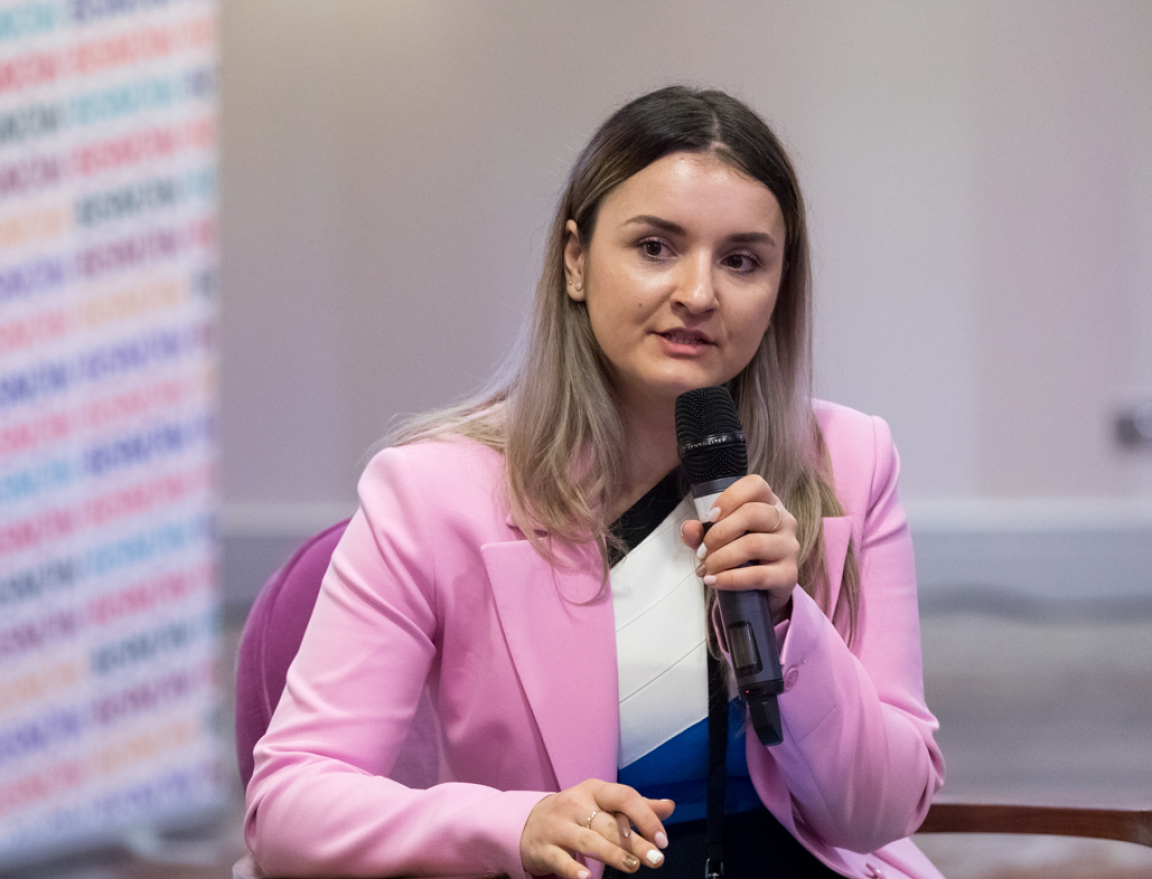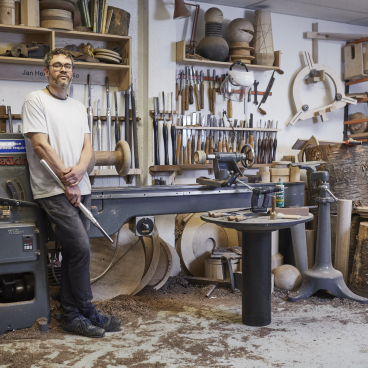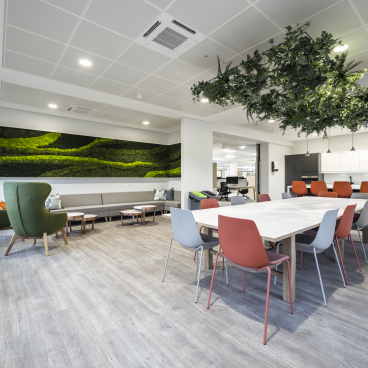Dr Catalina Ionita, architect at Chapman Taylor, PhD candidate, and design tutor, on grassroots placemaking, urban activation & environmental resilience.

Dr Catalina Ionita has creativity in her blood. She was brought up on it. From the combined artistic and entrepreneurial-spirited household in which she grew up, to the art school she attended from the age of 10. And when Catalina creates something, others take notice.
This common trajectory has underpinned her educational and professional career to date. In 2020, Catalina was honoured as part of RIBA’s Rising Stars shortlist for her project work and research into ethics and sustainability in architecture. She teaches the Masters of Architecture and Urbanism course one day a week at Manchester School of Architecture. She's a committee member and Inclusion Champion at Women in Property North West. Is undertaking a PhD in art-centred placemaking at Sheffield Hallam University. And this is all on top of her role as architect at Chapman Taylor.
On speaking to Catalina, one trait that’s immediately evident is her fervent drive to delve further in her practice to unearth new ways of doing things. And this isn’t just for her own professional development, but part of her desire to support her industry peers – she constantly knowledge shares to move process forward to a more sustainable and inclusive future.
With her PhD research on the cusp of being finalised, we asked Catalina if she would share some of her findings with us to kick off our editorial and event focus on property. Here, we talk authentic placemaking, what it means to be an ‘urban activator’, countering ‘aggressive gentrification’, the importance of ESG, and the towns and cities that are getting it right (and those with a way to go)…
Firstly, can you please give us an overview of your professional background?
“I am an architect in Chapman Taylor’s Manchester studio, with over ten years of experience working in the UK, where I've engaged with a variety of projects—from large residential developments and masterplans to offices and listed building restorations. Alongside architecture, I also teach the Master of Architecture and Urbanism course at the Manchester School of Architecture one day a week.
“My pursuit in architecture started with my former education in my home country, Romania, where I attended art school from the age of 10, studying music, fine art, and eventually architecture. I would say the arts background has profoundly influenced my approach to architecture, allowing me to integrate creative and experimental concepts into functional and commercially viable designs. It also became the stimulus for pursuing a PhD, now due for completion in July (fingers crossed!).
“As a personal ambition, I've always aimed to bring together my passions for the arts and architecture, and my PhD has provided a perfect platform for this exchange to happen. I see myself as someone practising at the fringe, as someone who constantly learns and experiments across different fields, always evolving transdisciplinarily, always drawing insights from one discipline to enrich another.”
What does your current role as architect at Chapman Taylor entail?
“In my role as an architect at Chapman Taylor, I am part of the residential team, primarily focusing on Build-to-Rent developments and masterplanning. My responsibilities are diverse, involving projects not only across the UK but also on an international scale, and encompassing all stages of the RIBA work stages framework. Most recently, I worked on the look and feel strategy of an airport in Greece.
“Additionally, I actively contribute to our Research & Development agenda. This involves continuously enhancing our practice-based knowledge and capabilities, particularly in the areas of residential buildings, mixed-use developments, and placemaking strategies.
“I find that my position at Chapman Taylor is dynamic and continually evolving. It resonates deeply with my research interests and educational interests, allowing me to integrate and apply my academic knowledge directly into my architectural practice. This synergy supports my professional development and contributes significantly to the innovative approach we take as a firm.”
Your PhD focuses on art-centred placemaking – please tell us more
“My PhD is building on the notion of placemaking, putting the arts at the core of activating our urban landscapes. The terminology I am using is ‘urban activation’. This study responds to the Government’s cultural placemaking agenda and investigates the potential of artist-led spaces to revitalise urban landscapes in response to several challenges within English cities such as poor-quality urban development, gentrification exacerbated by austerity, and declining support for the arts amid economic and political instability.
“The concept of an 'urban activator'—a term not yet clearly defined academically—typically refers to modest, often temporary, interventions in urban environments that stimulate development, enhance community engagement, and reinforce communal ownership. My research aims to fill a gap in existing scholarship by defining artist-led spaces as urban activators.
“Partnering with East Street Arts (ESA), a not-for-profit artist-led organisation in Leeds, the thesis examines how such entities operate on a neighbourhood scale, particularly in diverse and marginalised areas, to counter aggressive gentrification and raise environmental awareness. These artist-led initiatives emerge as grassroots tools that utilise underused urban spaces to address economic instability and the challenges of a post-pandemic world.
Ultimately, my thesis positions urban activators not merely as tools but as catalysts for authentic, community-integrated urban transformation.
“This work is an urgent call to recognise and leverage the transformative power of artist-led spaces, proposing a model for making our cities more vibrant, equitable, and responsive to the needs of their inhabitants.”
NB: "Artist-led" refers to spaces, organisations, or initiatives that are self-organised, not-for-profit, and collectively managed by artists. These entities are variously known as artist-led spaces, artist-run spaces, artist-led organisations, artist-run centres, and alternative spaces, among other labels. These terms emphasise the autonomy and collaborative nature of groups that operate independently of traditional commercial and institutional frameworks.
*Historically, the concept of artist-led initiatives has evolved since the early 19th Century, but saw significant development in the mid-20th Century, particularly during the 1950s through to the 1970s. This period marked a notable shift in the art scene, characterised by a rebellious spirit and an avant-garde push that challenged existing artistic boundaries.
The term "artist-run" emerged as a replacement for earlier terms like "alternative space" or "independent space," highlighting a focus on initiatives directly stemming from artists themselves. These spaces often serve as critical venues for experimental and emerging practices, reflecting a shift towards artist-centred models of operation and governance within the cultural sector.*
In simple terms, what does placemaking mean?
“Placemaking is a dynamic and multifaceted concept that encompasses the transformation of both the physical and social environments of urban areas. Rooted in practices of planning, urban design, architecture, geography, and sociology, placemaking has evolved since the mid-1960s from a focus on the physical redesign by urban designers to a broader, more inclusive process involving various community stakeholders.
“At its core, placemaking is about creating spaces that maximise shared value and strengthen the connections between people and the places they inhabit. This is echoed by Jane Jacobs, who emphasised that cities offer something for everyone "only when they are created by everybody."
I believe that through placemaking, we not only transform spaces but also enhance the social fabric of communities, making them more vibrant and inclusive places to live.
Can you share examples of cities or neighbourhoods that have done placemaking well?
Barcelona
“I believe Barcelona is a great model of placemaking, skilfully balancing material changes, cultural identity, and creative innovations to redefine its urban landscape. After Franco's regime, the city transformed itself through a major urban regeneration tied to the 1992 Olympics, which was pivotal in opening the city to the sea and creating vibrant new public spaces. This physical remodelling, alongside a rebranding of Barcelona from the 'Paris of the South' to the 'Capital of the Mediterranean', was supported by cultural icons like Miró, Dalí, and Picasso. This shift not only altered the city's image but also its functional reality, moving from a business-centric port to a cultural and leisure destination.
“The regeneration efforts led to an enriched public life and urban culture, resulting in increased tourism and economic activity, and establishing architectural landmarks that continue to draw global admiration. Noteworthy is the city’s commitment to innovative urban design, further exemplified by its pioneering "superblocks" initiative, a forward-thinking approach to urban planning that addresses contemporary needs for sustainability and quality of life. These superblocks, or "superilles" in Catalan, reconfigure the existing grid of the city to prioritise pedestrian spaces, reduce traffic, and increase green areas. By limiting vehicular access within these zones, the plan transforms urban blocks into quasi-pedestrian areas, fostering safer, cleaner, and quieter neighbourhoods.
“This initiative not only supports environmental sustainability by reducing air pollution and lowering noise levels but also enhances social interaction among residents. Public spaces previously dominated by cars are repurposed for community activities, playgrounds, and green spaces, encouraging more sustainable urban living, and improving the overall health of the population. The superblocks model in Barcelona serves as a blueprint for other cities worldwide, showcasing how urban centres can adapt to modern ecological challenges and public health needs while simultaneously enriching the urban fabric. This strategy aligns with Barcelona's broader placemaking efforts, demonstrating a commitment to rethinking urban spaces in ways that prioritise long-term sustainability and resident well-being.”
Altrincham
“If we look closer to home, I think Altrincham also serves as an example of placemaking done right, illustrating how local identity and architecture can drive urban revitalisation and foster community engagement. Once dubbed England’s emptiest high street in 2010 with over 30% of its shops vacant, Altrincham underwent a transformation that led it to be named the best high street in the country by 2018. Central to this revival was the reinvention of Altrincham Market.
“With a focus on creativity over profitability, the local council’s tender process enabled a group of residents to re-establish the market as a communal hub. This sparked further regeneration, prompting the revival of restaurants and businesses in the area. By 2019, Altrincham not only piloted the National High Street Perfect Day but also achieved record footfall, reducing its vacancy rate to just under 10%. This turnaround highlights Altrincham’s success in becoming an 'experience high street', proving the effectiveness of community-driven placemaking efforts in regenerating urban centres.”
Is there a ‘secret sauce’ to succeeding when it comes to placemaking?
“I don’t know about sauce, but definitely several key ingredients coming into it, for sure.
At the heart of effective placemaking, in my view, is a profound respect for the existing context—this involves deeply understanding the unique character, opportunities, and challenges of a place, as well as the aspirations of its people and how they interact with their environment.
“The process starts with engaging the community to ensure that developments are not imposed upon an area but are cultivated with consideration for its current state and residents. This approach helps prevent the creation of sterile, homogeneous spaces that lack identity and a true sense of place.
“Furthermore, adopting an inclusive mindset in design is essential. Beyond the important discussions around sustainability and environmental, social, and governance (ESG) factors, placemaking must prioritise inclusivity. This includes ensuring accessibility, addressing issues of marginalisation, and actively working to include minority voices in the planning process. Engaging a broad spectrum of stakeholders—from designers to local authorities—and opening up consultation processes to understand and integrate the diverse needs and desires of community members are crucial steps in creating spaces that resonate with and improve the lives of all users.
“I am a strong advocate for the impactful potential of grassroots placemaking—small-scale, ad-hoc initiatives led by residents, neighbourhood groups, and activists that respond to climate and social issues in their communities. An exemplary case is the Incredible Edible movement in Todmorden, which organically evolved to address local needs. This initiative effectively uses urban farming not only to produce food locally but also as a catalyst for broader discussions on sustainability, climate awareness, and the reliance on imported food.
“The success of such movements lies in their ability to seamlessly integrate into the existing community fabric, driven by a strong social agenda that fosters engagement and prompts action on pressing environmental and societal issues. This type of grassroots action exemplifies how localised efforts can lead to substantial, meaningful change in placemaking.”
Who's getting it wrong?
“While there is significant ambition and initiative aimed at creating better living and working environments, it's important to refine our focus. Instead of casting our net too broadly, honing in on localised strategies can be more impactful. This approach allows for the development of more inclusive urban design agendas that cater specifically to the needs of individual cities.
“In Manchester, for instance, there is substantial potential to enhance the urban experience by prioritising human-centric design principles. This includes fostering walkability and ensuring safety in public spaces, crucial elements that contribute to a city's liveability. Moreover, there is a pressing need to integrate more open green spaces within the city centre. Such spaces not only promote environmental sustainability but also encourage interaction across different age groups, creating a more interconnected and intergenerational community. By doing so, we can prevent the segregation of demographic groups within specific areas of Greater Manchester, fostering a more inclusive urban environment where everyone can thrive.”
How else does sustainability impact?
“Sustainability and placemaking are deeply intertwined; indeed, they should be considered synonymous. Effective placemaking must be responsive not only to its immediate context but also to broader environmental and ethical concerns. This holistic approach acknowledges the urgency of the climate emergency and integrates sustainability into the public realm, ensuring that urban development promotes environmental resilience and ethical practices.
The importance of inclusivity in this context cannot be overstated, especially as we tackle the global challenge of climate change. The impacts of climate change are universal, yet they do not affect everyone equally.
The UK's Climate Change Committee has highlighted that due to existing social inequalities, certain groups including women, minority populations, and the elderly face disproportionate risks. These groups often have lower incomes or serve as primary caregivers, which can limit their ability to respond to climate-related challenges such as flooding and air pollution.
“Given these disparities, my ambition in focusing on inclusive placemaking is to create urban environments that not only address sustainability but also prioritise the needs and safety of the most vulnerable groups. By integrating these principles, we can create spaces that are not only environmentally sound but also socially equitable. This approach will allow us to construct urban areas that are better prepared for the climate challenges ahead, ensuring that resilience is built into the very fabric of our cities and communities.”
How have you gone about your research in tandem with your role as an architect?
“I was lucky to work with people who understood the value of research and development, and allowed for someone with my academic focus to evolve and develop my research alongside my work as an architect. Initially at Coda Studios, now at Chapman Taylor, I have been lucky to contribute to my work as an architect with academic research that I have been developing through my PhD, enhancing my work and approaches.”
You’re a committee member for Women in Property – what does that involve?
“I joined the Women in Property North West Committee in February 2023 and my strategic role is Inclusion Champion. As part of this role, I am responsible for raising awareness about equality, diversity, and inclusion in the property sector, while creating opportunities for people to be heard. This is something that I was very passionate about before joining the Committee, especially as a foreign citizen working and living in the UK, so the role aligned really well with my views and ambitions.
“Since joining the Committee, I have organised a wide range of events specifically catered around inclusion such as:
A presentation titled ‘What would a city designed by women look like?’, complemented by a survey exploring women's experiences in Manchester's living and working environments.
EDI Training Sessions for Women in Property members and the broader community, covering topics like: Inclusive Leadership, Imposter Syndrome, Anti-Fat Bias, Inclusive Performance Management, Becoming an Inclusion Ally, Inclusive Language & Conversations, Unconscious Bias Awareness.
Moderating a Black History Month panel aimed at dismantling biases against black professionals in the property industry (collaborative event with RIBA).
Leading a Diversity Month panel on ‘Women’s Impact on Designing Spaces’ (collaborative event with RIBA).
Conducting the Invisible Cities Feminist Walking Tour in Manchester, highlighting significant contributions of women to the city's development.
Facilitating mentoring sessions with students from Sheffield Hallam University and Manchester Metropolitan University, focusing on EDI in the property sector.
Chairing an EDI panel at UKREiiF within Moda’s New Generation Talks Pavilion, discussing pivotal topics in the industry.”
What’s next? Both in terms of your studies, and project work?
“Currently, my primary focus is on completing my PhD in the coming months. Post-PhD, I aim to continue my research with a specific focus on inclusive placemaking, particularly within the context of Manchester, a city I consider my second home.
“My goal is to contribute to Manchester's evolution into an even more inclusive urban environment. I am optimistic about the potential to merge my professional projects with my academic insights, possibly leading to impactful outcomes such as a whitepaper or an Inclusive Urban Design Guide. One step at a time…”





